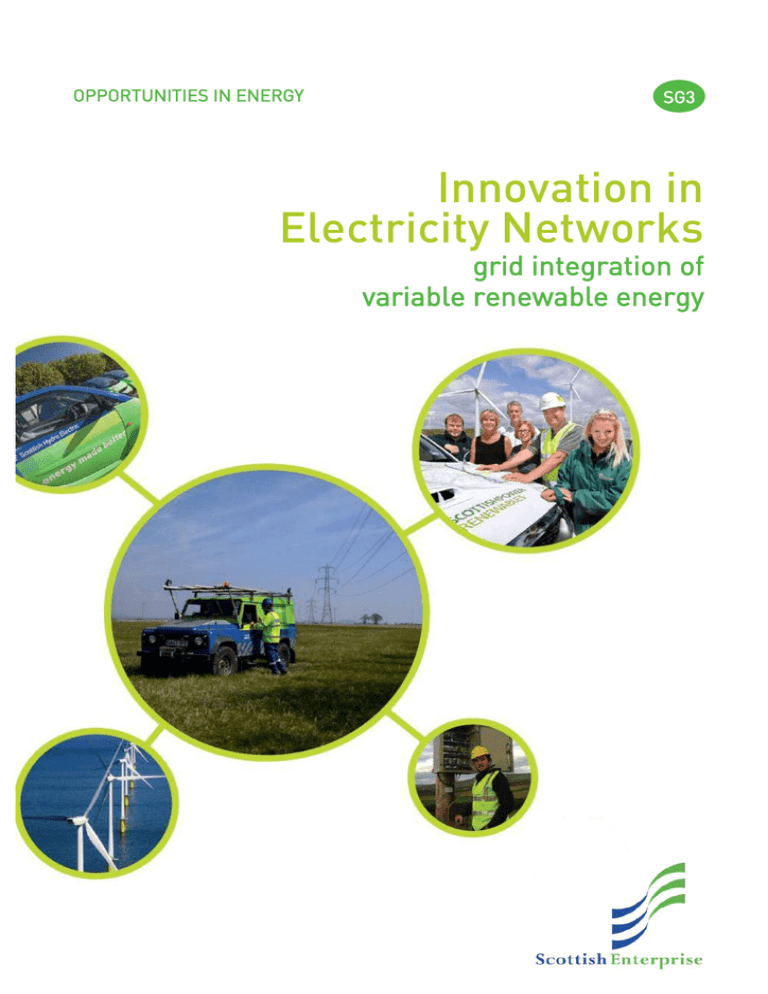Innovation in electricity networks: grid integration of variable
advertisement

OPPORTUNITIES IN ENERGY SG3 Innovation in Electricity Networks grid integration of variable renewable energy Contents Introduction ........................................................................................................................................... 1 Innovation in electricity networks ......................................................................................................... 1 The smart grid opportunity ................................................................................................................... 1 Grid integration of variable renewable energy ..................................................................................... 2 The challenges ....................................................................................................................................... 3 Market for grid integration of variable renewable energy ................................................................... 4 Summary ................................................................................................................................................ 5 How we support innovation ................................................................................................................... 6 Useful links ............................................................................................................................................ 7 Sources .................................................................................................................................................. 8 Acknowledgements ............................................................................................................................... 8 Introduction Scotland’s huge renewable energy resource coupled with its commitment to fulfil ambitious climate change targets offer the potential for Scotland to become one of the world leaders in renewable energy development. This, however, implies large amounts of variable renewable energy coming online in the next few years. This paper is the third in a series, authored in partnership with Highlands & Islands Enterprise, the Energy Innovation Centre and the Energy Technology Partnership, setting out the opportunities open to Scottish companies in the growing market for innovative products and services that will allow electrical power transmission and distribution networks to handle the ever-changing demands put on them by the changing mix of generation, as well as variations in consumption. New products and services are specifically needed to enable integrated power network systems (Smart Grids). This will allow more flexible, cheaper implementation of distributed power generation; mitigate the need for expensive infrastructure upgrades; and help overcome the variability of renewable power generation and the capacity constraints in existing networks. Innovation in electricity networks Recent market foresighting by Scottish Enterprise indicates that Scotland has existing company and academic strengths that can be developed and diversified to take advantage of the key market and technology opportunities in the areas of: New business models for supplying electricity and additional services; Customer energy management; Data acquisition, monitoring and analysis; Network automation and optimisation; High-Voltage Direct Current (HVDC); and, Energy storage. It should also be noted that opportunities exist for companies to develop products and services that improve the effectiveness and efficiency of, or reduce the cost of, operating, maintaining and reinforcing existing networks (the Energy Innovation Centre has published a list of the UK industry’s technology requirements on their website – see their Innovation Needs section). Further information can also be found on the Energy Networks Association ‘Smarter Networks’ portal. The smart grid opportunity The 2020 global market for Smart Grid products and systems has been estimated at £24 billion (range £18-£47 billion). The corresponding cumulative global market size taken over the period 2011-2020 has been estimated at approximately £185 billion (range £128-£292 billion). Significant growth is forecast for Europe and Asia. The European market is estimated at £12 billion in 2020; the Asian market at approx. £7 billion in 2020, with further expansion beyond that. (1) Grid integration of variable renewable energy A variety of options exist that can enable successful integration of Scotland’s significant renewable generation resources onto the electricity networks. Similar challenges are also occurring globally. ‘Appropriate adaptation’ of existing grids will mean they will be able to support significantly higher proportions of renewable energy. These include: upgrading the existing network; interconnection with other countries; demand side response; adding flexible generation to the grid; and incorporating storage (both large and small scale) into the system. The above technologies are required for the following reasons: To transmit electricity from areas of high generation to demand centres; To balance the electricity system, ensuring the generation supply is balanced with demand. This includes balancing the system in the event of loss of generation plant or loss of a transmission circuit; To balance local generation with local demand, avoiding the need for reinforcement. Based on findings from SE Foresighting research a number of technologies were identified as key areas of importance for Scotland in terms of enabling integration of renewable energy. These included: Active networks potentially incorporating demand side response (DSR) and distributed storage Reinforcement technologies, including multi-terminal VSC (Voltage Source Converter)-HVDC Interconnections with other countries also offer a significant potential, but opportunities appear to be more long-term. However this call is very broad and there could be a variety of possible solutions. Analysis shows that costs of integration technologies often exceed costs of curtailment of renewable generation. This is particularly significant for integration technologies at a distribution level. Technical solutions that approach or match curtailment costs would be particularly useful for reducing the overall costs of integration. A mid-point estimate of constraint costs is around £550/kW (based on annual curtailment costs of renewables in Scotland). (2) 2 The challenges Active networks This challenge was covered in an earlier opportunity paper on Network Automation & Optimisation. Most renewable generation is connected to the electricity distribution network – a network that has to date been of a passive design. Distribution networks of the future need to be better able to cope with the effects of this generation. They will need innovation in several key areas of information technology and control. Active control of networks using advanced sensors will be used to achieve higher degrees of network automation and better system control, while pervasive communications will allow networks to be reconfigured by intelligent systems. Protection and control systems will be able to react to faults and unusual transient behaviour and ensure recovery after such events. It is worth saying that affordable solutions should not be overlooked; it might be more about the innovative use of existing technology rather than developing new (expensive) technology. Demand Side Response Flexing the consumption of energy to match variable renewable energy production is the essence of demand side management. Demand side management business challenges include: new ways of supplying electricity; home energy management services; aggregation and trading of micro-generated electricity; etc. Customer energy management systems, data acquisition, monitoring and analysis of demand, generation and network data, products, services and integrated systems are also required. Another challenge area is the manufacturing of smart devices for consumer equipment, such as fridges, washing machines etc, to enable them to respond to demand levels. There is also a need for companies to capture a share of the smart meter market (particularly installation). Grid reinforcement and interconnection Scotland is a region of high generation and low demand, and it requires sufficient transmission infrastructure to allow for exporting excess of generation to regions of high demand. This implies provision of new network infrastructure and/or upgrades to the existing network – both of these are the types of reinforcement. Reinforcement can involve new or upgraded overhead lines, cables transformers and switchgear. The major risks to reinforcement projects are planning and consent issues and the financing of work. Scotland has historically also been a net exporter of electricity and exports around 20% of its generation to the rest of the UK. As well as exporting excess energy to the rest of the UK, there is potential for Scotland to connect to other neighbouring countries, in particular to those with large volumes of renewable generation. Such interconnection has a potential to play a significant role in balancing supply and demand (i.e. export at times of high supply and import during times of peak demand). In addition, electricity trading can lower the cost of electricity to consumers as cheaper sources of electricity can be made available. This may lead to a decrease in the costs of decarbonisation. The underlying technologies for the development of interconnectors are a subset of those technologies that are used for general reinforcements such as HVDC subsea cables. Many of the issues are similar to those experienced for reinforcements, such as planning, consenting and technical issues. But there are additional issues relating to the interconnection of countries and offshore grids. These include issues such as standardisation of voltages and differing arrangements for balancing and trading. 3 Storage There are many different forms of energy storage that may be feasible for widespread deployment. Energy storage could be a key method of addressing future energy challenges and not acting now would: endanger the stability of UK energy supply; increase the price of electricity to the consumer; and, miss valuable market opportunities by allowing overseas competitors (facing the same challenges) to develop solutions faster. Due to cost and functionality reasons only pumped hydro storage (a mechanical solution) has been widely deployed to date. Market for grid integration of variable renewable energy Active networks The current market for network automation and optimisation is substantial and is projected to grow rapidly in the next decade to come. As can be seen in figure 1 below (‘Grid’ column), projected spend on grid optimisation systems is expected to reach over 40% of the overall cumulative smart grid spend market by 2020 and be worth £120Bn of 10 years cumulative spend by 2030. Realistic total market spends by Smart Grid segments by 2030 Total Value 2011-30, £Bn Metering CEMS Data Grid EV Scotland 0.2 0.2 0.2 4.7 0.1 Great Britain 2.2 1.8 0.7 11.2 1.1 Europe 28.7 19.3 7.9 62.6 11.5 North America 11.6 8.2 3.3 18.3 13.4 Asia 28.7 8.5 10.4 21.7 5.7 Rest of World 4.4 1.2 2.0 1.7 0.2 Total 75.9 39.3 24.4 120.1 32.1 Source: Scottish Enterprise internal based on IPA (3) Total 5.5 17.1 129.9 54.9 75.0 9.5 291.8 Demand Side Response If we consider demand side response opportunities to cover smart metering, customer energy management systems (CEMS) and data acquisition and analysis, the cumulative value of these markets to 2020 will be worth £140Bn. Grid reinforcement and interconnection The Electricity Networks Strategy Group (ENSG) report “Our Electricity Transmission Network: Vision for 2020” (February 2012) specified the reinforcements required to be made to the existing transmission network in the UK and Scotland to incorporate changes in the future generation portfolio as part of a so-called “Gone Green” scenario. The total investment in reinforcement required in Scotland by 2020 to meet the “Gone Green” scenario has been estimated as £2.5 billion to connect 10.2GW of additional generation and a further £3.56 billion to reinforce links between Scotland and England that will enable them to accommodate a further 1.1GW. The European Network of Transmission System Operators for Electricity (ENTSO-E) estimates that around £85 billion of investment is required to develop European interconnectors over the next 10 years of which £19 billion is the cost of subsea cables. This investment is to be shared between 34 European countries with the UK’s share being the second highest at around £16 billion. (4) Storage The USA, China, Korea, Japan and Germany are amongst the countries making significant investments in storage technologies, so Scotland may need to act fast in order to remain competitive and ensure maximum economic benefit. California is planning to install 1,525MW 4 energy storage between 2014 and 2020. A market research firm predicted that global storage installations will grow to more than 6GW by 2017 and 40GW by 2022, with 43% of this market being in the USA up to 2017. (5) Global market The opportunities exist all over the world. The table below estimates projected geographical market sizes for network optimisation for three different scenarios. It shows that the potential cumulative UK market spend could exceed £20 billion by 2030 with about 40% of it in Scotland alone. The cumulative European market could potentially reach nearly £100 billion and the market elsewhere in the world ranges between £102 billion and £123 billion. Network optimisation cumulative capital spend to 2030 (£m) by region Conservative Realistic Scotland £4,531 £5,785 GB (ex. Scotland) £9,555 £14,485 Europe (ex. GB) £71,418 £78,117 Asia £23,543 £79,398 North America £78,462 £24,478 Rest of World £9,692 Optimistic £8,379 £19,673 £86,550 £96,584 £25,656 Source: IPA (6) Summary A variety of options exist for integrating renewables into the electricity network. Upgrading networks to be better able to cope with renewable energy through innovation in areas of information technology and control is one method (Active Network Management). Others include improving interconnections between networks; demand side response (DSR); adding more flexible generation to the grid; and, incorporating energy storage into the system. Each of these options represents a challenge and therefore an opportunity for Scotland to become a leader in technological development; export its skills and expertise; and, expand into international markets. 5 How we support innovation Annually, Scottish Enterprise spends between £15 million and £20 million to support research and development and innovation. It has a number of Research & Development and Innovation support mechanisms that can assist companies from the early stages of investigating market and technical feasibility; through product, process or service development; to market launch. Where a company’s R&D or Innovation project presents a convincing technical and commercial case Scottish Enterprise will identify how best to support your project. This could include reimbursement of eligible costs at: up to 70% for feasibility studies; or, depending on company size, up to 35% for closer to market R&D projects (further reimbursement, up to 15%, may be available if Scottish Enterprise deems the project to be multi-participant collaborative R&D). Academic and Research Institutes with early stage, ‘proof of concept’ projects that present a convincing case could be awarded up to 100% reimbursement of eligible costs. In a global economy, the ability to innovate can determine the success or growth of a business and in turn, an economy. Of all the triggers for success, the ability to innovate is perhaps the most critical, and therefore the biggest challenge. Highlands & Islands Enterprise spends around £8m per annum to support account-managed businesses develop fresh thinking through a variety of support programmes and also discretionary grant support. The Scottish Investment Bank supports the development of Scotland’s private sector small- and medium-sized enterprise (SME)1 funding market to ensure both early stage and established businesses with growth and export potential have adequate access to growth capital. It operates a suite of investment funds. The three equity funds (Scottish Seed Fund, the Scottish Co-Investment Fund and the Scottish Venture Fund) adopt a highly innovative co-investment and shared risk intervention model to encourage more private investors to invest in early stage Scottish companies with high growth potential. SIB is also the lead investor in the privately managed Scottish Loan Fund which operates on a fully commercial basis and is aimed at established companies. The Energy Innovation Centre is a partnership between Electricity North West, National Grid, Northern Gas Networks, Northern Powergrid, Scotia Gas Networks, SP Energy Networks, Scottish & Southern Energy Power Distribution, UK Power Networks and Wales & West Utilities. It exists to bring energy innovation and industry together. It can help to translate ideas into a commercial reality through access to energy funding for innovation (the Innovation Funding Incentive, the Low Carbon Network Fund, the Network Innovation Stimulus) and access to industry customers and commercial expertise. Funding obtained through the Energy Innovation Centre is considered private funding and as a result is not subject to state aid regulations. The Energy Technology Partnership is an alliance of twelve independent Scottish Universities, engaged in world-class energy research, development and demonstration. With access to 250 academics and 700 researchers, and over £250 million of testing facilities through the Scottish Energy Laboratory, it can provide the spark businesses need to get their ideas into the market. The Energy Technology Partnership does not charge for its time and can provide business and technology development support, help in finding and securing innovation funding, and guidance in identifying suitable testing facilities. It can support SME R&D projects by funding academic time to assist with company innovation (actual funding is determined on a case-by-case basis). 1 http://ec.europa.eu/enterprise/policies/sme/facts-figures-analysis/sme-definition/index_en.htm 6 The Power Networks Demonstration Centre is a venture between the University of Strathclyde, Scottish Enterprise, the Scottish Funding Council, Scottish Power and Scottish and Southern Energy aimed at accelerating the adoption of novel research and technologies into the electricity industry. It aims to meet the needs of utilities, equipment manufacturers (including SMEs) and academia by providing a unique facility for research, development, demonstration and commercialization of novel technologies. This unique, world-class, collaborative research, development and demonstration venture offers a range of services: Access to indoor and outdoor laboratories Equipment and expert staff for research Support for licensing and commercialisation Collaborative ventures Technology demonstrations Useful links Scottish Enterprise –Smart Grids http://www.scottish-enterprise.com/knowledge-hub/articles/guide/smart-grid-funding-introduction Scottish Enterprise – Innovation support service http://www.scottish-enterprise.com/iss Scottish Enterprise – Develop new products and services http://www.scottish-enterprise.com/services/develop-new-products-and-services Scottish Enterprise – Attract investment http://www.scottish-enterprise.com/services/attract-investment Scottish Enterprise –Proof of concept programme http://www.scottish-enterprise.com/services/support-for-entrepreneurs/proof-of-conceptprogramme/overview Scottish Enterprise – Scottish Energy Laboratory www.scottishenergylaboratory.com Highlands & Islands Enterprise – Research and Development Funding http://www.hie.co.uk/business-support/funding/research-and-development-funding/default.html Energy Innovation Centre http://www.energyinnovationcentre.com/ Energy Technology Partnership http://www.etp-scotland.ac.uk/ Power Networks Demonstration Centre http://www.strath.ac.uk/pndc/ Scottish & Southern Energy Power Distribution Innovation Strategy – RIIO-ED1 2015-2023 http://www.yourfutureenergynetwork.co.uk/12_innovation2014.pdf 7 Scottish Hydro Electric Transmission Ltd Innovation Strategy – RIIO-T1 2013-2021 http://www.ssepd.co.uk/uploadedFiles/Controls/Lists/Resources/Compliance_report(1)/SHETL_InnovationStr ategyUpdateJanuary2012.pdf SP Energy Networks Innovation Strategy – RIIO-ED1 2015-2023 http://www.spenergynetworks.co.uk/pages/distribution_business_plan_supporting_annexes.asp SP Transmission Innovation Strategy – RIIO-T1 2013-2021 http://www.spenergynetworks.co.uk/userfiles/file/2011_SPTL_Narrative_8%20Innovation%20Strategy.pdf Sources 1. C.Brys (Scottish Enterprise), Scottish Opportunities in Smart Power Grids, June 2011. 2. Scottish Enterprise, Integrating Variable Renewable Generation into the Grid, June 2014 3. IPA Energy + Water Economics, Smart Grid Market Analysis – Report to Scottish Enterprise, February 2012. 4. European Network of Transmission System Operators for Electricity, 10-Year Network Development Plan 2012, July 2012 5. pv magazine (www.pv-magazine.com), Grid connected storage market set to explode, January 2014 6. IPA Energy + Water Economics, Smart Grid Market Analysis – Report to Scottish Enterprise, March 2011. Acknowledgements Front cover images courtesy of: SSE, Scottish Power, Skills Development Scotland, Smarter Grid Solutions, Ewgeco and Scottish Enterprise. Page 3 images courtesy of: Scottish Enterprise, University of Strathclyde. 8




